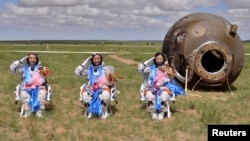China has completed its longest manned space mission yet, marking an important step toward the goal of building its own space station.
The return capsule of the Shenzhou-10 spacecraft touched down safely early Wednesday in China's remote Inner Mongolia region. The three astronauts aboard waved and smiled for the cameras after emerging from the capsule.
During their 15 days in space, the astronauts successfully docked with and carried out other tests on the Tiangong-1 experimental space module. China views the orbiting lab as a prototype for a permanent space station it hopes to build by 2020.
Asia space analyst and author Morris Jones tells VOA that while China's latest mission did not break any major new ground, it showed that its previous accomplishments in space were not flukes.
"Showing that you can do it once is one thing, but showing that the technology works time and time again is where you build up that track record and that confidence in the reliability in the systems and the procedures," said Jones.
Although it remains behind the U.S. and Russia, China's space program has made major breakthroughs in a relatively short time. In 2003, China sent its first astronaut to space. Five years later, it completed its first spacewalk.
Joan Johnson-Freese, an expert on China's space program at the National Defense University, tells VOA that China has been able to use its space program to become seen as one of the world's "technology leaders."
"This has meant a lot to them economically, in terms of political clout regionally and globally, and it's really given them a boost in their scientific and engineering programs in terms of student enrollment," said Johnson-Freese.
Johnson-Freese also points out that 95 percent or more of space technology is dual-use, meaning it has both a civilian and military application.
It is those concerns about China's military-backed space program that have prevented the U.S. from cooperating with China in space, effectively barring Beijing from the International Space Station project.
But many analysts, including Johnson-Freese, say the U.S. restriction is counter-productive, and will not keep China from working harder and faster to achieve its goals in space.
The return capsule of the Shenzhou-10 spacecraft touched down safely early Wednesday in China's remote Inner Mongolia region. The three astronauts aboard waved and smiled for the cameras after emerging from the capsule.
During their 15 days in space, the astronauts successfully docked with and carried out other tests on the Tiangong-1 experimental space module. China views the orbiting lab as a prototype for a permanent space station it hopes to build by 2020.
Asia space analyst and author Morris Jones tells VOA that while China's latest mission did not break any major new ground, it showed that its previous accomplishments in space were not flukes.
"Showing that you can do it once is one thing, but showing that the technology works time and time again is where you build up that track record and that confidence in the reliability in the systems and the procedures," said Jones.
Although it remains behind the U.S. and Russia, China's space program has made major breakthroughs in a relatively short time. In 2003, China sent its first astronaut to space. Five years later, it completed its first spacewalk.
Joan Johnson-Freese, an expert on China's space program at the National Defense University, tells VOA that China has been able to use its space program to become seen as one of the world's "technology leaders."
"This has meant a lot to them economically, in terms of political clout regionally and globally, and it's really given them a boost in their scientific and engineering programs in terms of student enrollment," said Johnson-Freese.
Johnson-Freese also points out that 95 percent or more of space technology is dual-use, meaning it has both a civilian and military application.
It is those concerns about China's military-backed space program that have prevented the U.S. from cooperating with China in space, effectively barring Beijing from the International Space Station project.
But many analysts, including Johnson-Freese, say the U.S. restriction is counter-productive, and will not keep China from working harder and faster to achieve its goals in space.










